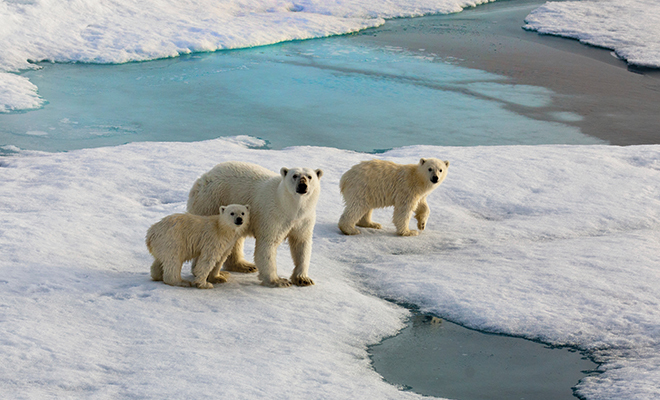
Is Global Warming a Myth?
The scientific evidence for climate change–significant alterations in temperature, precipitation and wind patterns that occur over decades–is strong. Climate change deniers’ claims are easy to refute. Not everyone listens, but facts are powerful things.
Claim: Climate change is part of the natural cycle. Human influence is minuscule. Fact: Since the Industrial Revolution in the 1700s, climate change has been caused primarily by human-generated greenhouse gases such as carbon dioxide, methane and ozone, sending billions of tons of these heat-trapping gases into the atmosphere. In the distant past, meteors, volcanoes and other natural causes created climate change, but those fluctuations were temporary. These changes are permanent.
Claim: Scientists differ on whether there is climate change. Fact: Deniers claim that 31,000 American scientists signed the Oregon Petition, declaring they did not accept that climate change was real. But the petition was open for anyone, not just scientists, and signers included Spice Girls and Star Wars characters. In fact, 97 percent of climate scientists accept that climate change is real, a statistic backed up by articles in peer-reviewed scientific journals.
Claim: The sun is getting warmer, which is the real cause of global climate change. Fact: If that were true, then days would warm faster than nights and the entire atmosphere, upper and lower, would become warmer. In fact, the opposite is true. Nights are warming faster than days and the upper atmosphere is getting cooler. These are indicative of human influence.
Claim: Global warming stopped in 1997. Fact: There is simply no truth to this rumor. The four hottest years on record were 2014, 2010, 2007 and 2005. Oceans, which hold 90 percent of the extra heat, continue warming. Since 1880, the global average temperature has increased 1.4º, with half of that occurring since 1970. Last year was the hottest year on record worldwide.
While debate continues among civilians, the U.S. military is taking climate change seriously. The U.S. Department of Defense released a report in 2014 saying that “Climate change may cause instability in other countries by impairing access to food and water, damaging infrastructure, spreading disease, uprooting large numbers of people, compelling mass migration, interrupting commercial activity or restricting electricity availability. Gaps in governance can create an avenue for extremist ideologies and conditions that foster terrorism.”
“While scientists are converging toward consensus on future climate projections, this cannot be an excuse for delaying action,” wrote Defense Secretary Chuck Hagel in the Department of Defense 2014 Climate Change Adaptation Road Map. His foreword notes that DOD is studying the implications for the National Guard in response to the aftermath of natural disaster.
So, what could happen over the course of the next 100 years if nothing is done?
An expected rise in ocean levels (up to three feet) means flooding on coasts, the most populated areas of the world, with more than 150 million people in the United States directly affected. Thousands of homes, businesses, manufacturing areas and entertainment districts would be underwater. Building sea walls won’t always help. In cities with high water tables such as Miami, the water will simply bubble up from below. Elsewhere, the problem of water scarcity in urban areas would spread.
Extreme weather conditions would become more common. Frequent intense storms, mudslides and floods would wash away roads and rails. Seaports could submerge, disrupting worldwide shipping. The changing pH of ocean water would cause die-offs of creatures such as shellfish. Fish, able to move to accommodate a change of temperature, would migrate, although some species might disappear altogether.
The range and occurrence of human diseases would increase, especially insect- and water-borne diseases such as malaria, West Nile virus, Lyme disease, dengue and cholera. Heat waves and air pollution could result in higher rates of cardiovascular diseases and asthma.
So-called breadbasket regions could become too dry or hot to sustain staple food crops like wheat, corn or rice, although longer growing seasons might increase the yields of some crops. Plant diseases and insect infestation would expand while boreal (northern) and tropical forests, which help mitigate climate change by removing carbon dioxide from the air, would die or retreat.
Claim: I’m just one person. Even if it’s true, I can’t do anything to help. While a changing climate cannot be reversed, it can be halted. You can help. Here’s how. Cut down on one of the biggest sources of greenhouse gases by choosing a car rated at 32 mpg or better. If possible, drive less and walk or use public transportation. Contact your utility company to switch to renewable power.
Support clean power plants, which would cut greenhouse gases by 30 percent over the next five years, and energy-efficient technologies, businesses and products. Buy ENERGY STAR® appliances and LED bulbs. Contact your state and national representatives and let them know that you support efforts to regulate and control climate change.
Twenty-three percent of Americans still deny climate change, responding to rational arguments with a loud and unscientific presence on the Internet. Let us hope that rational arguments will have some effect. Not everyone listens, but facts are powerful things. HLM
Sources: www.acq.osd.mil, cdc.gov, epa.gov, huffingtonpost.com, ncdc.noaa.gov, newsweek.com, rtcc.org, salon.com, ucsusa.org and wpro.who.int.







